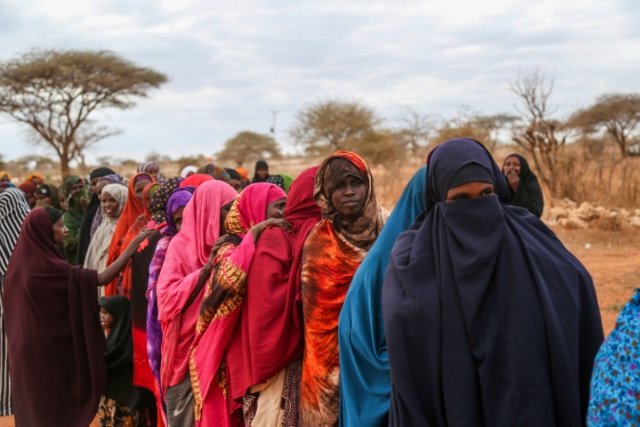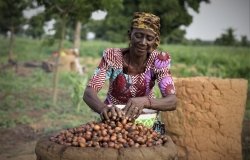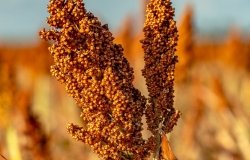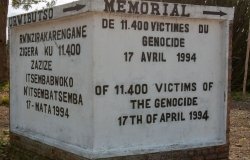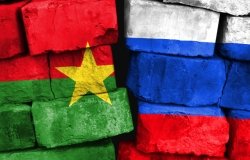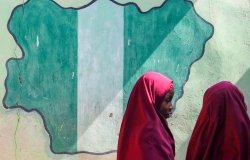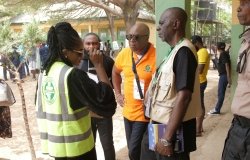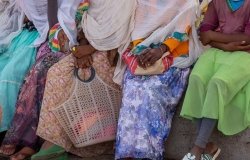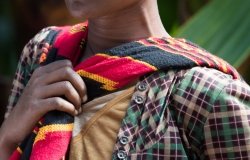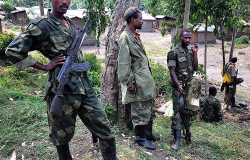
A blog of the Africa Program
Cause and Effect: Climate Change and Gender-Based Violence in East Africa
Climate change has thrown East Africa into its worst drought in over four decades, contributing to widespread acute food insecurity and displacement. While climate change is not the sole contributor to these calamities — socio- and geopolitical factors are also to blame — it acts as a threat multiplier, aggravating underlying socio-political tensions and increasing communities' susceptibility to political and economic insecurity.
Women are at particularly high risk of vulnerability during climate-caused natural disasters. During natural disasters such as drought, women are less likely to receive relief goods and more likely to experience a loss of livelihood compared to men, contributing to higher rates of socioeconomic insecurity, physical vulnerability, and death. Studies show that the death rates of women and children are fourteen times higher than that of men during natural disaster events,¹ decreasing women's life expectancy.² Furthermore, the United Nations Environment Programme (UNEP) estimates that 80% of people displaced by climate change worldwide are women.
Women Refugees
According to UN High Commissioner for Human Rights Michelle Bachelet, when women are displaced, they experience a greater risk of gender-based violence (GBV), including sexual assault, human trafficking, and forced child marriage. "While they sleep, wash, bathe or dress in emergency shelters, tents or camps, the risk of sexual violence is a tragic reality of their lives as migrants or refugees," Bachelet says. "Compounding this is the increased danger of human trafficking, and child, early and forced marriage which women and girls on the move endure."
The impact of displacement on the breakdown of traditional familial and communal means of support puts women in increasingly vulnerable situations, as it makes it more difficult for these women to receive necessary resources and services.
In refugee camps or other temporary housing with limited access to privacy, women are more likely to experience sexual violence while sleeping, washing, bathing, and dressing. According to workers at the Ainabo Health Center in Somalia, incidence of sexual violence in nearby refugee camps has more than quadrupled since the drought began, while many more go unreported due to stigmatization.
Additionally, the danger that sexual assault poses to young girls in refugee camps has decreased their access to education. Families have begun to pull their girls out of school to protect them from the long walks between school and camps, considered hotspots of sexual violence. Along migration routes toward Kenyan refugee camps, there have been reports of women and girls being targeted for human trafficking. Even local authorities and aid workers pose a danger, as some have committed violence themselves while others have imprisoned victims looking for help to protect powerful perpetrators.
Women at Home
Women at home are similarly experiencing increased incidence of GBV due to the impacts of climate change. As families who rely on seasonal rains for crop and livestock production struggle to provide for their children, an increased number of girls as young as twelve have been forced to undergo female genital mutilation in preparation for dowry-producing child marriages. In areas of Ethiopia experiencing the most severe impacts of drought, child marriage more than doubled from 2021 to 2022.
A UNEP study conducted in Uganda has found a relationship between drought and an increase in sexual exploitation of women hoping to purchase goods, food, or rent. Women who are not able to pay certain prices are manipulated into providing sexual intercourse in exchange for the goods they need.
In some regions of Kenya, over 90% of open water sources have dried up, making it difficult if not impossible for women to collect water nearby. During periods of drought, women across East Africa travel further distances to collect water for their families. Further distances traveled into less familiar terrain heightens women's exposure to the risk of sexual and physical violence. The further distances necessary to fetch water have simultaneously led to a decrease in access to education for young girls, who must help their mothers carry water home or take over other household tasks in their absence.
Drought has also been associated with increased levels of intimate partner violence, especially among young and unemployed women. When women return home from long treks for water, they may be too physically exhausted for sexual intercourse, leading some husbands to respond with violence. Furthermore, some men have turned to alcohol in response to the threat that poor harvests, livestock loss, and lower earnings pose to their traditional role as providers. The use of alcohol as a coping mechanism has been shown to increase the incidence of physical violence against their wives or partners.
Moving Forward
To effectively address the reality of climate change on the ground in East Africa, it is essential to take an intersectional approach to climate projects. Actors working in the field of climate adaptation on the continent must analyze climate disasters through multiple frameworks, such as the lens of GBV.
Local and international humanitarian organizations can provide support by specifically directing aid towards women both in the long term and when disaster strikes, thus minimizing the gender aid disparity. They can also work to promote long-term assistance for women by mentoring groups of community members who can serve as support systems for women at high risk of GBV, particularly in refugee camps where traditional systems of community support have been eroded.
National and local governments can better support refugee women and girls by implementing legal frameworks that will promote refugees' integration into society and economic self-reliance, thus providing these individuals with educational and economic opportunities that can limit their vulnerability to GBV. Kenya has numerous legal frameworks and plans, for example, that have yet to be fully implemented. By further developing the enactment of the 2021 Refugee Act, the regional Marshall Plan, and the Kalobeyei Integrated Socio-Economic Development Plan in Turkana West, to name a few, the national and local governments of Kenya can work to provide women with opportunities outside of refugee camps.
International governments, particularly those of the countries that contribute the most to the climate crisis, have a responsibility to provide financial support to communities experiencing the devastating effects of climate change. This was recently acknowledged in November 2022 during the Conference of Parties 27 (COP27), when nations from around the world agreed to the creation of a loss and damage fund. A loss and damage fund will provide financial assistance to countries that experience a breakdown of physical and social infrastructure in the wake of extreme weather events.
The details of the fund have yet to be sorted out, and few nations have made significant cash pledges to loss and damage. To protect women and girls from climate change induced GBV, international governments can pledge money to build social infrastructure that supports families who lose livelihoods in the wake of extreme weather events. This will simultaneously reduce the incidence of intimate partner violence against women in response to livelihood loss, reduce the incidence of child marriage used as a last-ditch source of economic income, and reduce the incidence of women and girls migrating to areas of high vulnerability like refugee camps.
These are just a few examples of actions that the local and international community can take to prevent further climate change induced GBV. Moving forward, local and global organizations working at the intersection of climate adaptation and humanitarian aid must work to protect vulnerable women from perpetrators of violence by offering support programs and working to hold the culprits accountable. Furthermore, organizations must draw from and amplify the local expertise of individuals currently working on the ground to protect their own communities. Through targeted interventions that address both the drivers of climate change induced GBV and the effects of GBV on women's ongoing health and wellbeing, actors could aid in protecting those who are the most vulnerable to climate change from one of its threat-multiplying effects.
¹ Peterson, Kristina. "From the field: gender issues in disaster response and recovery." Natural Hazards Observer 21, no. 5 (1997): 3-4. ² Neumayer, Eric, and Thomas Plümper. "The gendered nature of natural disasters: The impact of catastrophic events on the gender gap in life expectancy, 1981–2002." Annals of the association of American Geographers 97, no. 3 (2007): 551-566.
Amanda Clark is the Staff Intern at the Wilson Center Africa Program for the Spring 2023 term (January-April). She is a recent graduate of Muhlenberg College, where she received a B.A. in Sustainability Studies with a focus on international sustainable development.
Photo Credit: Kenyan women stand in line by Faid Elgziry/Shutterstock.
The opinions expressed on this blog are solely those of the authors. They do not reflect the views of the Wilson Center or those of Carnegie Corporation of New York. The Wilson Center's Africa Program provides a safe space for various perspectives to be shared and discussed on critical issues of importance to both Africa and the United States.
Climate change has thrown East Africa into its worst drought in over four decades, contributing to widespread acute food insecurity and displacement. While climate change is not the sole contributor to these calamities — socio- and geopolitical factors are also to blame — it acts as a threat multiplier, aggravating underlying socio-political tensions and increasing communities' susceptibility to political and economic insecurity.
Women are at particularly high risk of vulnerability during climate-caused natural disasters. During natural disasters such as drought, women are less likely to receive relief goods and more likely to experience a loss of livelihood compared to men, contributing to higher rates of socioeconomic insecurity, physical vulnerability, and death. Studies show that the death rates of women and children are fourteen times higher than that of men during natural disaster events,¹ decreasing women's life expectancy.² Furthermore, the United Nations Environment Programme (UNEP) estimates that 80% of people displaced by climate change worldwide are women.
Women Refugees
According to UN High Commissioner for Human Rights Michelle Bachelet, when women are displaced, they experience a greater risk of gender-based violence (GBV), including sexual assault, human trafficking, and forced child marriage. "While they sleep, wash, bathe or dress in emergency shelters, tents or camps, the risk of sexual violence is a tragic reality of their lives as migrants or refugees," Bachelet says. "Compounding this is the increased danger of human trafficking, and child, early and forced marriage which women and girls on the move endure."
The impact of displacement on the breakdown of traditional familial and communal means of support puts women in increasingly vulnerable situations, as it makes it more difficult for these women to receive necessary resources and services.
In refugee camps or other temporary housing with limited access to privacy, women are more likely to experience sexual violence while sleeping, washing, bathing, and dressing. According to workers at the Ainabo Health Center in Somalia, incidence of sexual violence in nearby refugee camps has more than quadrupled since the drought began, while many more go unreported due to stigmatization.
Additionally, the danger that sexual assault poses to young girls in refugee camps has decreased their access to education. Families have begun to pull their girls out of school to protect them from the long walks between school and camps, considered hotspots of sexual violence.
Along migration routes toward Kenyan refugee camps, there have been reports of women and girls being targeted for human trafficking. Even local authorities and aid workers pose a danger, as some have committed violence themselves while others have imprisoned victims looking for help to protect powerful perpetrators.
Women at Home
Women at home are similarly experiencing increased incidence of GBV due to the impacts of climate change. As families who rely on seasonal rains for crop and livestock production struggle to provide for their children, an increased number of girls as young as twelve have been forced to undergo female genital mutilation in preparation for dowry-producing child marriages. In areas of Ethiopia experiencing the most severe impacts of drought, child marriage more than doubled from 2021 to 2022.
A UNEP study conducted in Uganda has found a relationship between drought and an increase in sexual exploitation of women hoping to purchase goods, food, or rent. Women who are not able to pay certain prices are manipulated into providing sexual intercourse in exchange for the goods they need.
In some regions of Kenya, over 90% of open water sources have dried up, making it difficult if not impossible for women to collect water nearby. During periods of drought, women across East Africa travel further distances to collect water for their families. Further distances traveled into less familiar terrain heightens women's exposure to the risk of sexual and physical violence. The further distances necessary to fetch water have simultaneously led to a decrease in access to education for young girls, who must help their mothers carry water home or take over other household tasks in their absence.
Drought has also been associated with increased levels of intimate partner violence, especially among young and unemployed women. When women return home from long treks for water, they may be too physically exhausted for sexual intercourse, leading some husbands to respond with violence.
Furthermore, some men have turned to alcohol in response to the threat that poor harvests, livestock loss, and lower earnings pose to their traditional role as providers. The use of alcohol as a coping mechanism has been shown to increase the incidence of physical violence against their wives or partners.
Moving Forward
To effectively address the reality of climate change on the ground in East Africa, it is essential to take an intersectional approach to climate projects. Actors working in the field of climate adaptation on the continent must analyze climate disasters through multiple frameworks, such as the lens of GBV.
Local and international humanitarian organizations can provide support by specifically directing aid towards women both in the long term and when disaster strikes, thus minimizing the gender aid disparity. They can also work to promote long-term assistance for women by mentoring groups of community members who can serve as support systems for women at high risk of GBV, particularly in refugee camps where traditional systems of community support have been eroded.
National and local governments can better support refugee women and girls by implementing legal frameworks that will promote refugees' integration into society and economic self-reliance, thus providing these individuals with educational and economic opportunities that can limit their vulnerability to GBV. Kenya has numerous legal frameworks and plans, for example, that have yet to be fully implemented. By further developing the enactment of the 2021 Refugee Act, the regional Marshall Plan, and the Kalobeyei Integrated Socio-Economic Development Plan in Turkana West, to name a few, the national and local governments of Kenya can work to provide women with opportunities outside of refugee camps.
International governments, particularly those of the countries that contribute the most to the climate crisis, have a responsibility to provide financial support to communities experiencing the devastating effects of climate change. This was recently acknowledged in November 2022 during the Conference of Parties 27 (COP27), when nations from around the world agreed to the creation of a loss and damage fund. A loss and damage fund will provide financial assistance to countries that experience a breakdown of physical and social infrastructure in the wake of extreme weather events.
The details of the fund have yet to be sorted out, and few nations have made significant cash pledges to loss and damage. To protect women and girls from climate change induced GBV, international governments can pledge money to build social infrastructure that supports families who lose livelihoods in the wake of extreme weather events. This will simultaneously reduce the incidence of intimate partner violence against women in response to livelihood loss, reduce the incidence of child marriage used as a last-ditch source of economic income, and reduce the incidence of women and girls migrating to areas of high vulnerability like refugee camps.
These are just a few examples of actions that the local and international community can take to prevent further climate change induced GBV. Moving forward, local and global organizations working at the intersection of climate adaptation and humanitarian aid must work to protect vulnerable women from perpetrators of violence by offering support programs and working to hold the culprits accountable. Furthermore, organizations must draw from and amplify the local expertise of individuals currently working on the ground to protect their own communities. Through targeted interventions that address both the drivers of climate change induced GBV and the effects of GBV on women's ongoing health and wellbeing, actors could aid in protecting those who are the most vulnerable to climate change from one of its threat-multiplying effects.
¹ Peterson, Kristina. "From the field: gender issues in disaster response and recovery." Natural Hazards Observer 21, no. 5 (1997): 3-4.
² Neumayer, Eric, and Thomas Plümper. "The gendered nature of natural disasters: The impact of catastrophic events on the gender gap in life expectancy, 1981–2002." Annals of the association of American Geographers 97, no. 3 (2007): 551-566.
Amanda Clark is the Staff Intern at the Wilson Center Africa Program for the Spring 2023 term (January-April). She is a recent graduate of Muhlenberg College, where she received a B.A. in Sustainability Studies with a focus on international sustainable development.
Photo Credit: Kenyan women stand in line by Faid Elgziry/Shutterstock.
The opinions expressed on this blog are solely those of the authors. They do not reflect the views of the Wilson Center or those of Carnegie Corporation of New York. The Wilson Center's Africa Program provides a safe space for various perspectives to be shared and discussed on critical issues of importance to both Africa and the United States.
About the Author


Africa Program
The Africa Program works to address the most critical issues facing Africa and US-Africa relations, build mutually beneficial US-Africa relations, and enhance knowledge and understanding about Africa in the United States. The Program achieves its mission through in-depth research and analyses, public discussion, working groups, and briefings that bring together policymakers, practitioners, and subject matter experts to analyze and offer practical options for tackling key challenges in Africa and in US-Africa relations. Read more
